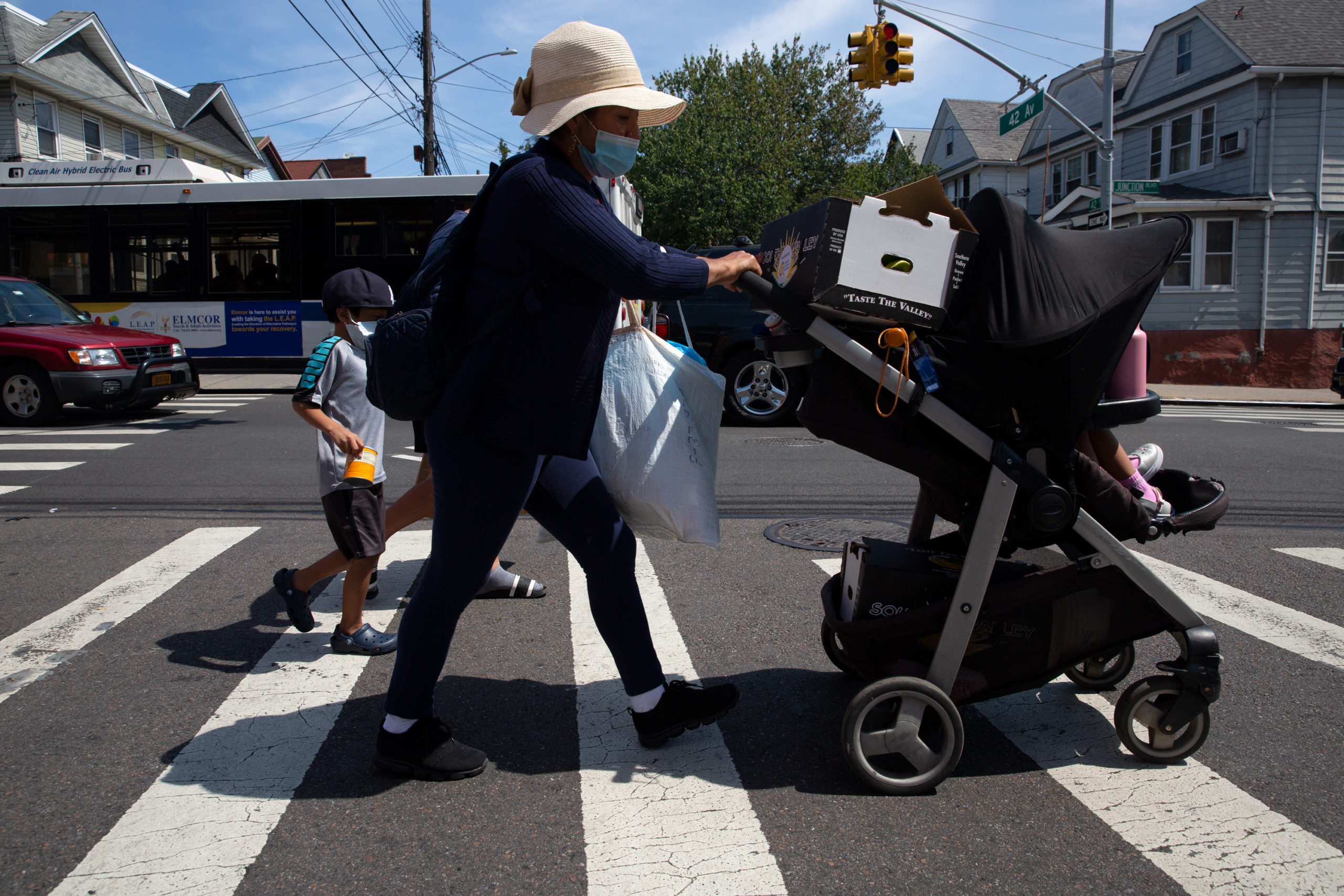The pandemic recession recovery isn’t reaching New York City mothers who face steep challenges in breaking back into the workforce — underscoring a growing child care crisis, a new report from a children’s advocacy group found.
The report by the nonprofit Citizens’ Committee for Children, shared with The Fuller Project and THE CITY, found that 41% of 25- to 54-year-old women living with children in the New York metropolitan area were not working between April and July.
That 41% was an improvement over the 50% of women who had reported being out of work at the peak of the pandemic economic shutdowns a year earlier. But male parents’ employment made a much bigger recovery, the report found, with the share of dads out of the workforce dropping from 45% to 24%.
“Women and women of color are really being very hard hit on many levels, like income loss, job loss and being pulled out of the workforce due to child care responsibilities,” said Jennifer March, the group’s executive director. “It seems like their recovery is slow right now.”
The Census numbers showed women who reported being Hispanic/Latino as the likeliest to report not working, at 55%. Among Black non-Hispanic women, 46% reported not working, while that figure was 39% Among Asian non-Hispanic women and 36% among white non-Hispanic women.
Making Child Care Flexible
The Citizens Committee for Children culled the data from the Census Bureau’s Household Pulse Survey, an effort by the Census Bureau to take demographic snapshots of the pandemic’s effect.
The New York City women surveyed between April 23 and July 5 were two and a half times more likely than men in the same age range to list child care as the primary reason for being out of the workforce, according to the analysis.
For Yansy Henriquez of the Bronx, balancing the cost of child care with how much she earns at a local beauty salon has made her question her ability to stay in the workforce.
To afford the nearly $800-a-month price tag of her baby’s day care during the pandemic, Henriquez cut down on internet, cable, her cell phone plan, clothing and even food.
And despite being quickly accepted into affordable child care programs for her older children over a decade ago, she said she has never even received a response from city programs for her 1-year-old daughter.
“Is there not a way to make child care more flexible for low-income moms?” Henriquez, 39, asked in Spanish. “Because I know that all those mothers who have child care, they’re going out looking for jobs and working. But if not, if they don’t have help, they can’t.”
‘People Want to Work’
While news articles abound on the challenges some employers have had in finding workers, child care experts and community organizers in New York City told THE CITY and The Fuller Project there is more to the story — especially for low-income mothers.
“People do want to go to work,” said Mirtha Santana, chief program officer at RiseBoro, a Brooklyn-based nonprofit that offers social services. “But when it becomes [a decision between] either working or having a better child care situation for your child, especially when that job is minimum wage, people make their choices.”
The pandemic temporarily shut down child care centers and job-placement sites where parents could get help signing up for child care, while making other support resources more difficult to access.
Meanwhile, remote and hybrid school were still in place for most public school students during the span of the Census survey, requiring intensive family support for students learning at home.
“I’m surprised it’s not a larger number, to be honest with you,” said Dawn Mastoridis, Child Care Director at Queens Community House, a multi-service settlement house and community resource center, referring to the percentage of New York mothers who were not working at the end of the last school year.
“Women have always historically been the primary caregivers who had to stay at home with children, and the process to get child care coverage is not an easy one,” said Mastoridis, who has helped shepherd parents through applying for subsidized child care.
In addition to dealing with long wait times for resources like child care vouchers, the amount of paperwork required to apply for that help can be a huge barrier for parents, advocates say.
This is especially true for parents with non-traditional jobs offering little or no documentation of employment, or for parents dealing with language barriers, said Mastoridis.
“It’s a challenge,” she added. “You have to have a lot of stamina and perseverance, and I could see why parents might give up on the process.”
Bleeding Money to Stay Working
For mothers who can’t access city-run child care programs, paying out-of-pocket can be untenable in the long term.
Jaime-Jin Lewis, Founder and CEO of WiggleRoom, a tech firm that aims to increase access to child care, said some parents will bleed money simply to stay in the workforce.
“I worked with multiple women who paid more for child care than they took home just because they wanted to have a job,” said Lewis. “They thought that they would have more opportunities in the future even though they were quite literally losing money to go to work.”
Tahvia Walter, a 29-year-old mother of two from Brownsville, Brooklyn, has been waiting for the right job to jump back into work. Low wage jobs just won’t cut it anymore, she said.
When she first lost her last minimum-wage job in May, Walter said, she felt a “sigh of relief.”
She was able to help her 8-year-old daughter do better in remote schooling. Walter also didn’t have to worry about bringing COVID-19 back home to her family — or about whether she would be allowed to take time off to care for a sick or quarantining kid.
She wishes that the city would do more to help mothers like her find positions “that are worth your while” — with benefits, flexibility around family life and a liveable wage.
Walter said she has turned down positions that didn’t offer work-family balance.
“They [the employers] put it in plain terms: ‘We come before anything,’ and I will fight because nothing comes before my children,” she said.
Federal, State Help on Horizon
Some see hope in the paid family leave and child care provisions in the Biden administration’s $1.75 trillion Build Back Better bill.
The bill, which passed the House on Friday morning, earmarks $400 billion in child care spending on universal preschool for 3- and 4-year-olds.
Although the federal package would be a big step, State Sen. Jabari Brisport (D-Brooklyn), who chairs the chamber’s Committee on Children and Families, said more needs to be done to ensure all mothers can access child care.

“It’s always good to have more money invested into the child care sector. I will say it’s definitely not as aggressive as it could be,” said Brisport, who said he’s committed to passing universal child care — with no income requirement — at the state level.
Gov. Kathy Hochul echoed Brisport’s commitment to expanding access to child care during an online child care listening tour event hosted by the Brooklyn Democrat last Wednesday.
“As I’m preparing my first budget, child care is a major priority,” said Hochul over Zoom. “I plan to work with [Brisport] to craft a strategy that is going to be transformative to address the needs of these families and the challenges of providers.”
At the city level, Mayor-elect Eric Adams has pledged to expand access to child care.
“Child care is a moral imperative, period,” Adams tweeted during his primary campaign while highlighting his plan to provide child care for “all who need it.”
For her part, Walter finally “took that leap” and accepted a new government job she believes will allow her to balance family and work. She is due to start in January.
“Going to work feels like you’re potentially sacrificing your health, the health of your kids,” she said. “So making a sacrifice like that to make minimum wage and pennies is not something that I think a lot of people are willing to do.”


 Jessica Washington
Jessica Washington
